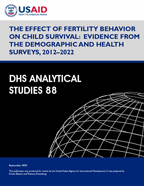There is no printed copy available to order.
Abstract:
Reducing child mortality is a major public
health concern. Its causes are widely
debated. This is the fourth
and largest study in a series of papers based
on Demographic and Health Surveys that
examine the
relationship between birth spacing and infant
and child mortality, which has been shown in
numerous
studies to be associated. The first DHS study
included 17 surveys from 1990 to 1997, the
second expanded
to 52 surveys from 2000 to 2005, and the
third included 45 surveys from 2006 to 2012.
The current study
includes 84 surveys from 56 countries, which
were conducted from 2012 to 2022. There are
no overlapping
surveys between the third study and present
study. All surveys in this report were
publicly available as of
July 2023. As in the third study, this report
includes analysis of the association of
maternal age and birth
order on mortality.
Over 3.7 million births in the 179 months
before the surveys are included in the
estimates of mortality for
under 5 and child (age 1–5) mortality. Almost
1.3 million of these births took place in the
59 months before
the surveys and are included in the analysis
of early neonatal mortality (within 6 days of
birth), neonatal
mortality (age 0–1 month), post-neonatal
mortality (age 1–11 months), and infant
mortality (age 0–11
months). The study presents summary
statistics for individual surveys and pooled
results for bivariate and
multivariate Cox hazard regressions for
mortality.
As found in previous studies, short birth
intervals are associated with an increased
risk of mortality for all
age groups in this analysis. This is
consistent for both the unadjusted and
adjusted models. The shorter the
birth interval, the greater the odds. First
born children also experience greater odds of
mortality than higher
order children who were conceived three to
four years after their next oldest sibling.
With maternal age, the pattern is also
similar to the most recent study, with
children born to young mothers
(under age 18) having an increased risk of
mortality for all six mortality measures, and
children born to
women over age 35 having an increased risk
for mortality before age 1, but similar risks
to the reference
group (women age 18–24) for child and under-5
mortality.
The risk of mortality is highest for children
with birth order 7 or greater. For birth
orders 5 and 6, mortality
risks are higher than the reference group
(parity 1 and 2) after the neonatal period.
Combining information on spacing, maternal
age, and birth order, a child with two risk
factors faces over a
50% increased risk of dying in the early
neonatal period, neonatal period, the post-
neonatal period, and
infant period compared to a child with no
risk factors. The children’s risk of dying
under age 5 is 130%
higher than a child with no risk. A child
with all three risk factors has a risk of
dying that is over 100%
higher than a child with no risk in all
mortality groups.
 The Effect of Fertility Behavior on Child Survival: Evidence from the Demographic and Health Surveys, 2012–2022 (PDF, 2010K)
The Effect of Fertility Behavior on Child Survival: Evidence from the Demographic and Health Surveys, 2012–2022 (PDF, 2010K)
 The Effect of Fertility Behavior on Child Survival: Evidence from the Demographic and Health Surveys (AS88) - Analysis Brief
The Effect of Fertility Behavior on Child Survival: Evidence from the Demographic and Health Surveys (AS88) - Analysis Brief
